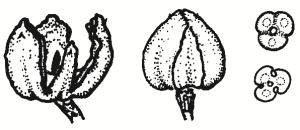Family:
Cupressaceae
Callitris glaucophylla
White Cypress Pine
(syn. C. columellaris)
Other Names: Murray Pine

Name Origin:
glaucophylla — from Greek glaucos, silvery or bluish-green, and phyllon, leaf, referring to bluish foliage.
Regional Subspecies:
Similar Species:
Distinguished from Black Cypress Pine (C. endlicheri) by its cones and bluish foliage (Black Cypress Pine typically has greener foliage). Triangular pyramid or single column emerging from base of inside of fruit, while Black Cypress Pine has three segments in fruit.
Occurrence:
Regional:
Widespread in drier country west of Hume Highway. Also noted in Mullengandra, Four Mile and Livingstone areas.
Australia:
Mainland states.
Habitat:
Mostly sandy soils. From isolated individuals to extensive forests, especially in inland districts.
Habit:
Tree to 20 m high, with single trunk. Bluish-grey foliage and rough, deeply furrowed bark.
Site Preference:
Well-drained soil. Tolerates extended dry periods and frost.
Characteristics:
Hardy. Young plants sensitive to fire, although older trees more tolerant. Relatively slow to mature, but long-lived.
Seed Collection:
Late Nov to late Apr. Requires close monitoring as seeds released 3-8 weeks after maturity. Cones easily collected from outer foliage using secateurs (each cone contains about 20 seeds). Good seed crops generally produced every 3 years on trees over 40 years old. Refrigerate stored seeds.
Propagation:
From seed (± 20 viable seeds per gram) sown around Sep for intended autumn planting, or during summer for autumn planting the following year, if better developed trees are preferred. Cover seeds with about 5 mm potting mix. Some growers recommend stratifying seeds in freezer for 2 weeks prior sowing.
Regeneration:
From seed. Seedlings extremely palatable to livestock and rabbits, hence fencing required to encourage regeneration. Establishes reasonably well when direct seeded.
VALUES:
Shade & Shelter:
Useful long-lived medium-level cover in windbreaks, providing shelter virtually to ground- level.
Wildlife:
Mature trees, particularly when growing with Bulloak (Allocasuarina luehmannii) and Grey Box (Eucalyptus microcarpa), important habitat for Grey-crowned Babbler and Apostlebird, which forage in foliage and on ground nearby. Thick fibrous bark supports abundant supply of grubs and insects not found in such quantities in eucalypts. Wide range of other insect-eating birds forage in trees. Parrots and cockatoos feed on seed-bearing cones.
Fuel:
Good fuel. Splits and ignites readily. Fragrant when burned.
Timber:
Highly valued for resistance to decay in ground, termite resistance and very small shrinkage on seasoning. Saws and nails well when freshly felled. Largely used for building scantlings, flooring, linings and weatherboards, with small-diameter round material used for fencing and small poles. Useful timber for bottom boards of beehives in contact with ground. Timber usually light coloured, although sometimes dark brown, of moderate weight. Tends to be brittle. Finely and evenly textured, straight-grained, aromatic and often knotty. Knots tightly held, and sometimes regarded as feature in polished surfaces.
First Nations:
Along Murray River, resin provided waterproof adhesive, and wood used for making implements including woomeras, canoe poles and spear shafts. Leaves contain pinene, an antiseptic oil. Leaves smoked over fire or soaked to make a wash, or mixed with fat to make ointment for colds.
Ornamental:
Attractive for parks, gardens and avenues, and tubs.
Other:
Pollen yielded in useful quantities, and benefits bees.
